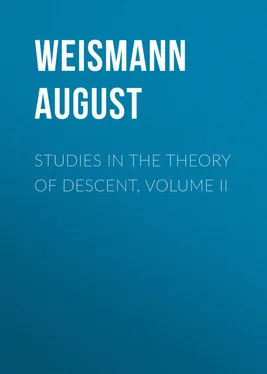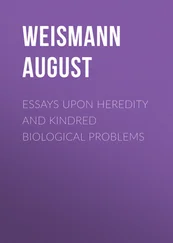August Weismann - Studies in the Theory of Descent, Volume II
Здесь есть возможность читать онлайн «August Weismann - Studies in the Theory of Descent, Volume II» — ознакомительный отрывок электронной книги совершенно бесплатно, а после прочтения отрывка купить полную версию. В некоторых случаях можно слушать аудио, скачать через торрент в формате fb2 и присутствует краткое содержание. Жанр: foreign_antique, foreign_prose, на английском языке. Описание произведения, (предисловие) а так же отзывы посетителей доступны на портале библиотеки ЛибКат.
- Название:Studies in the Theory of Descent, Volume II
- Автор:
- Жанр:
- Год:неизвестен
- ISBN:нет данных
- Рейтинг книги:4 / 5. Голосов: 1
-
Избранное:Добавить в избранное
- Отзывы:
-
Ваша оценка:
- 80
- 1
- 2
- 3
- 4
- 5
Studies in the Theory of Descent, Volume II: краткое содержание, описание и аннотация
Предлагаем к чтению аннотацию, описание, краткое содержание или предисловие (зависит от того, что написал сам автор книги «Studies in the Theory of Descent, Volume II»). Если вы не нашли необходимую информацию о книге — напишите в комментариях, мы постараемся отыскать её.
Studies in the Theory of Descent, Volume II — читать онлайн ознакомительный отрывок
Ниже представлен текст книги, разбитый по страницам. Система сохранения места последней прочитанной страницы, позволяет с удобством читать онлайн бесплатно книгу «Studies in the Theory of Descent, Volume II», без необходимости каждый раз заново искать на чём Вы остановились. Поставьте закладку, и сможете в любой момент перейти на страницу, на которой закончили чтение.
Интервал:
Закладка:
It may also occur that the early stages are variable, whilst the later stages are constant, although this case appears to happen less frequently. Thus, the caterpillars of Gastropacha Quercifolia vary considerably in the second stage but are constant at a later period, and the same is the case with Spilosoma Urticæ , which in the second stage may be almost considered to be dimorphic, but which subsequently becomes constant.
Cases in which the first stage is variable appear to be of the least frequent occurrence. I know of only one such instance, viz., Anceryx Pinastri , of which the newly hatched larvæ ( Pl. VI Конец ознакомительного фрагмента. Текст предоставлен ООО «ЛитРес». Прочитайте эту книгу целиком, купив полную легальную версию на ЛитРес. Безопасно оплатить книгу можно банковской картой Visa, MasterCard, Maestro, со счета мобильного телефона, с платежного терминала, в салоне МТС или Связной, через PayPal, WebMoney, Яндекс.Деньги, QIWI Кошелек, бонусными картами или другим удобным Вам способом.
., Fig. 53) show considerable differences in the brownish-black crescentic spots. The second ( Fig. 54 Конец ознакомительного фрагмента. Текст предоставлен ООО «ЛитРес». Прочитайте эту книгу целиком, купив полную легальную версию на ЛитРес. Безопасно оплатить книгу можно банковской картой Visa, MasterCard, Maestro, со счета мобильного телефона, с платежного терминала, в салоне МТС или Связной, через PayPal, WebMoney, Яндекс.Деньги, QIWI Кошелек, бонусными картами или другим удобным Вам способом.
), third, and fourth stages are then tolerably constant, while the fifth stage again is very variable.
An instance of this kind can be easily explained by two waves of variation, the first of which now affects only the first stage, while the second has just commenced to affect the fifth stage. Such a supposition is not opposed to any theoretical considerations, but rather has much probability in its favour, since we know that species are from time to time subject to be remodelled; and further, that the coalescence of several stages of phyletic development in the ontogeny of one and the same species (see p. 226, development of the genus Deilephila ) shows that during the backward transference of one character, new characters may appear in the last stage of the ontogeny, and indeed very frequently at a time when the next youngest character has not been transferred back so far as to the first stage.
That this secondary variability is to a certain extent brought about by the conflict between the old and new characters, the latter striving to suppress the former, is shown by the caterpillar of Saturnia Carpini which I have observed for many years from this point of view, and than which I do not know a more beautiful illustration.
When these larvæ leave the egg they are black, but in the adult state are almost bright green – this at least being the case in a local form which, from the district in the vicinity of Genoa where it is found, I will designate as the var. Ligurica . Now whilst these two extreme stages of development are relatively constant, the intermediate stages show a variability which becomes greater the nearer the last stage is approached, this variation in the marking depending simply on the struggle between the green colour and the more anciently inherited black. In this manner there arises, especially in the fourth stage of the German local form, an incredible mixture of the most diverse markings, all of which can, however, be very easily explained from the foregoing point of view.
The simpler and, as I am inclined to believe, the older form of the transformation is presented to us in the local variety Ligurica . In the last stage, when 7.5 centimeters long, this form is of a beautiful bright green colour without any trace of black marking 4 4 It is true that I only reared one brood, but from this fifty specimens were obtained. It would be interesting to know whether this variety of the caterpillar is distributed over the whole of Southern Europe.
( Pl. VIII Конец ознакомительного фрагмента. Текст предоставлен ООО «ЛитРес». Прочитайте эту книгу целиком, купив полную легальную версию на ЛитРес. Безопасно оплатить книгу можно банковской картой Visa, MasterCard, Maestro, со счета мобильного телефона, с платежного терминала, в салоне МТС или Связной, через PayPal, WebMoney, Яндекс.Деньги, QIWI Кошелек, бонусными картами или другим удобным Вам способом.
., Fig. 77). The colour of the six orange warts which are situated on each segment is also similar in all specimens, so that this stage is perfectly constant.
Our German S. Carpini shows different characters in the fifth stage. It is true that individual specimens occur which are entirely green without any black, but these are rare; the majority possess a more or less broad black ring encircling the middle of each segment ( Pl. VIII Конец ознакомительного фрагмента. Текст предоставлен ООО «ЛитРес». Прочитайте эту книгу целиком, купив полную легальную версию на ЛитРес. Безопасно оплатить книгу можно банковской картой Visa, MasterCard, Maestro, со счета мобильного телефона, с платежного терминала, в салоне МТС или Связной, через PayPal, WebMoney, Яндекс.Деньги, QIWI Кошелек, бонусными картами или другим удобным Вам способом.
., Figs. 78 and 79). Those specimens in which the black ring has become broken up into large or small spots surrounding the base of the warts constitute intermediate forms ( Fig. 80 Конец ознакомительного фрагмента. Текст предоставлен ООО «ЛитРес». Прочитайте эту книгу целиком, купив полную легальную версию на ЛитРес. Безопасно оплатить книгу можно банковской картой Visa, MasterCard, Maestro, со счета мобильного телефона, с платежного терминала, в салоне МТС или Связной, через PayPal, WebMoney, Яндекс.Деньги, QIWI Кошелек, бонусными картами или другим удобным Вам способом.
). The last stage of the German local form, unlike that of the Genoese local form, is therefore very variable.
The two forms, moreover, do not simply differ in being more or less advanced in phyletic development, but also in several other points. As it is of great theoretical interest to show that a species can develop local differences only in the stage of larva, I will here subjoin the plain facts.
The differences consist in that the Genoese local form goes through five moults whilst the German local form, like most caterpillars, has only four moults. Further, in the Genoese form the light green, which is also possessed by the German form in the fourth stage, when it once appears, is retained to the end of the larval development, whilst in the fifth stage of the German form this colour is replaced by a dull greyish-green (compare Figs. 77 and 78 Конец ознакомительного фрагмента. Текст предоставлен ООО «ЛитРес». Прочитайте эту книгу целиком, купив полную легальную версию на ЛитРес. Безопасно оплатить книгу можно банковской картой Visa, MasterCard, Maestro, со счета мобильного телефона, с платежного терминала, в салоне МТС или Связной, через PayPal, WebMoney, Яндекс.Деньги, QIWI Кошелек, бонусными картами или другим удобным Вам способом.
). There is further a very considerable difference in the earlier stages which shows that the phyletic transforming process has taken a quite independent course in the two forms. Since the struggle between the green and black – retaining this idea – appears to be quite finished in the last stage of the Genoese form, we should expect that the new colour, green, would now also have encroached further upon the younger stages than in the German form. Nevertheless, this is not the case, but quite the reverse happens, the black maintaining its ground longer in the Italian than in the German form.
Интервал:
Закладка:
Похожие книги на «Studies in the Theory of Descent, Volume II»
Представляем Вашему вниманию похожие книги на «Studies in the Theory of Descent, Volume II» списком для выбора. Мы отобрали схожую по названию и смыслу литературу в надежде предоставить читателям больше вариантов отыскать новые, интересные, ещё непрочитанные произведения.
Обсуждение, отзывы о книге «Studies in the Theory of Descent, Volume II» и просто собственные мнения читателей. Оставьте ваши комментарии, напишите, что Вы думаете о произведении, его смысле или главных героях. Укажите что конкретно понравилось, а что нет, и почему Вы так считаете.












